Keeping Things Clean on the Japan Sea Coast
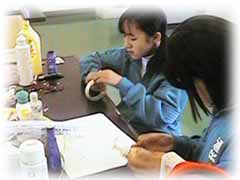 Kayoi Middle School in the city
of Nagato, Yamaguchi Prefecture, is surrounded by natural beauty. There are 109
students attending the school, of whom 23 girls belonging to the gardening club
are also members of the school's Eco Club.
Kayoi Middle School in the city
of Nagato, Yamaguchi Prefecture, is surrounded by natural beauty. There are 109
students attending the school, of whom 23 girls belonging to the gardening club
are also members of the school's Eco Club.
The school had an active environment program
for years before the Eco Club was launched in 1997. Its students have been involved
in collecting aluminum cans for recycling, for instance, and cleaning up nearby
neighborhoods. Some students have also surveyed the quality of the surrounding
sea water. The Eco Club began as an extension of these activities and was made
part of the gardening club because beautifying the school environment was thought
to be a good starting point.
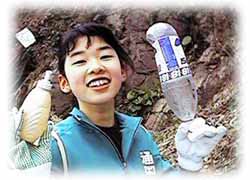 During the 1997 school year, club members collected
litter along nearby Ogoshi Beach several times. What's interesting about these
outings is the kind of garbage that washes up on shore.
During the 1997 school year, club members collected
litter along nearby Ogoshi Beach several times. What's interesting about these
outings is the kind of garbage that washes up on shore.
"About
a fourth to a third of the items that flow in are from foreign countries," claims
Yukihiro Furuta, the Kayoi Middle School teacher who supervises its Eco Club activities.
"They're brought here by the Tsushima Current, which flows into Nagato from the
south. You get a lot of foreign items especially in autumn and winter because
of westerly winds."
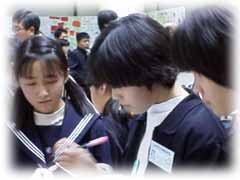 In one project, Eco Club members checked which
countries the items were from and created a table that was displayed at school.
In one project, Eco Club members checked which
countries the items were from and created a table that was displayed at school.
Foreign garbage most frequently comes from South
Korea, followed by China, Taiwan, and Singapore. A lot of plastic bottles, cardboard
boxes, and candy wrappings wash up; there have also been a few large items, like
a freezer for ice cream.
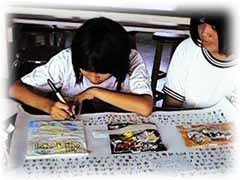 Besides keeping the beach clean and keeping tabs
on what washes ashore, club members also regularly check the water quality at
two rivers: the Fukawa and Koya. These activities were summarized in a wall newspaper,
which was posted at the national Eco Club convention as the representative work
of Yamaguchi Prefecture clubs.
Besides keeping the beach clean and keeping tabs
on what washes ashore, club members also regularly check the water quality at
two rivers: the Fukawa and Koya. These activities were summarized in a wall newspaper,
which was posted at the national Eco Club convention as the representative work
of Yamaguchi Prefecture clubs.
During the remainder of the 1998 school year,
the Kayoi Eco Club plans to measure how much air pollution plants absorb and study
the influence of pollutants called hormone disruptors on ibonishi and other
shellfish.
The
students are no strangers to beautiful natural surroundings, having been brought
up right next to the Sea of Japan," says club supervisor Mr. Furuta. "Even those
who weren't very enthusiastic about keeping the environment clean have become
quite interested in the topic as we explored environmental themes close by."
A ninth grader who will be graduating from the
school in March 1999 said she hoped to persuade younger students to continue making
an effort to preserve Nagato's natural surroundings.
Photos: Club members do everything from experiments to clean-up work
to presentations on their activities. (Yukihiro Furuta)

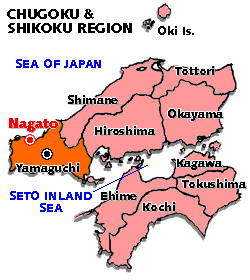
 Kayoi Middle School in the city
of Nagato, Yamaguchi Prefecture, is surrounded by natural beauty. There are 109
students attending the school, of whom 23 girls belonging to the gardening club
are also members of the school's Eco Club.
Kayoi Middle School in the city
of Nagato, Yamaguchi Prefecture, is surrounded by natural beauty. There are 109
students attending the school, of whom 23 girls belonging to the gardening club
are also members of the school's Eco Club. During the 1997 school year, club members collected
litter along nearby Ogoshi Beach several times. What's interesting about these
outings is the kind of garbage that washes up on shore.
During the 1997 school year, club members collected
litter along nearby Ogoshi Beach several times. What's interesting about these
outings is the kind of garbage that washes up on shore. In one project, Eco Club members checked which
countries the items were from and created a table that was displayed at school.
In one project, Eco Club members checked which
countries the items were from and created a table that was displayed at school. Besides keeping the beach clean and keeping tabs
on what washes ashore, club members also regularly check the water quality at
two rivers: the Fukawa and Koya. These activities were summarized in a wall newspaper,
which was posted at the national Eco Club convention as the representative work
of Yamaguchi Prefecture clubs.
Besides keeping the beach clean and keeping tabs
on what washes ashore, club members also regularly check the water quality at
two rivers: the Fukawa and Koya. These activities were summarized in a wall newspaper,
which was posted at the national Eco Club convention as the representative work
of Yamaguchi Prefecture clubs.